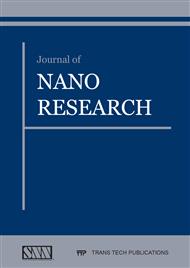[1]
M S Lee, K Lee, S Y Kim, et al. High-Performance, Transparent, and Stretchable Electrodes Using Graphene-Metal Nanowire Hybrid Structures. Nano Letters, 13 (6), (2013), 2814-2821.
DOI: 10.1021/nl401070p
Google Scholar
[2]
X Li, Y Wei, L Lu, K Lu, H Gao. Dislocation nucleation governed softening and maximum strength innano-twinned metals. Nature, 464 (2010), 877–880.
DOI: 10.1038/nature08929
Google Scholar
[3]
A Misra, H Krug. Deformation Behavior of Nanostructured Metallic Multilayers. Advanced EngineeringMaterials, 3(4), (2001), 217-222.
DOI: 10.1002/1527-2648(200104)3:4<217::aid-adem217>3.0.co;2-5
Google Scholar
[4]
A Misra, H Kung, J D. Embury, Preface to the viewpoint set on: deformation and stability of nanoscalemetallic multilayers. Scripta Materialia, 50(6), (2004), 707-710.
DOI: 10.1016/j.scriptamat.2003.11.036
Google Scholar
[5]
Y Yuan, Y F Gu, T Osada, et al. A new method to strengthen turbine disc superalloys at service temperatures. Scripta Materialia, 66(11), (2012), 884-889.
DOI: 10.1016/j.scriptamat.2012.01.025
Google Scholar
[6]
R G Hoagland, J P Hirth, A Misra. On the role of weak interfaces in blocking slip in nanoscalelayered composites. Philosophical Magazine, 86(23), (2006), 3537-3558.
DOI: 10.1080/14786430600669790
Google Scholar
[7]
S M Hafez Haghighat, G Eggeler, D Raabe. Effect of climb on dislocation mechanisms and creep rates in γ'-strengthened Ni base superalloy single crystals: A discrete dislocation dynamics study. Acta Materialia, 61(10), (2013), 3709-3723.
DOI: 10.1016/j.actamat.2013.03.003
Google Scholar
[8]
C R Dandekar, Y C Shin. Modeling of machining of composite materials: A review. International Journal of Machine Tools and Manufacture, 57, (2012), 102-121.
DOI: 10.1016/j.ijmachtools.2012.01.006
Google Scholar
[9]
Z Tong, Y C Liang, X Q Jiang, X C Luo. An atomistic investigation on the mechanism of machiningnanostructures when using single tip and multi-tip diamond tools. Applied Surface Science, 290 (2014),458–465.
DOI: 10.1016/j.apsusc.2013.11.113
Google Scholar
[10]
A Stukowski. Structure identification methods for atomistic simulations of crystalline materials. Modelling and Simulation in Materials Science and Engineering. 20, (2012), 1-15.
DOI: 10.1088/0965-0393/20/4/045021
Google Scholar
[11]
R Komanduri, N Chandrasekaran, L M Raff. MD Simulation of nanometric cutting of single crystalaluminum-effect of crystal orientation and direction of cutting. Wear, 242 (2000), 60–88.
DOI: 10.1016/s0043-1648(00)00389-6
Google Scholar
[12]
R Komanduri, N Chandrasekaran, L M Raff. MD simulation of exit failure in nanometric cutting.Material Science Engineering A, 311 (2001), 1–12.
DOI: 10.1016/s0921-5093(01)00960-1
Google Scholar
[13]
A V Verkhovtsev, AV Yakubovich, G.B Sushko, et al. Molecular dynamics simulations of the nanoindentation process of titanium crystal. Computational Materials Science, 76,(2013):20-26.
DOI: 10.1016/j.commatsci.2013.02.015
Google Scholar
[14]
Y Gao, C Lu, N H Huynh, et al. Molecular dynamics simulation of effect of indenter shape onnanoscratch of Ni. Wear, 267(2009): 1998-(2002).
DOI: 10.1016/j.wear.2009.06.024
Google Scholar
[15]
T H Fang, J H Wu. Molecular dynamics simulations on nanoindentation mechanisms of multilayeredfilms. Computational Materials Science, 43 (2008), 785–790.
DOI: 10.1016/j.commatsci.2008.01.066
Google Scholar
[16]
Y Z Cao, J J Zhang, Y C Liang, et al, Mechanical and tribological properties of NiAl multilayers—Amolecular dynamics study. Applied Surface Science, 257 (2010), 847–851.
DOI: 10.1016/j.apsusc.2010.07.079
Google Scholar
[17]
P Peng, G.L Liao, T.L Shi, Z.R Tang, Y Gao, Molecular dynamic simulations of nanoindentation inaluminum thin film on silicon substrate, Applied Surface Science, 256 (2010) 6284–6290.
DOI: 10.1016/j.apsusc.2010.04.005
Google Scholar
[18]
H W Zhao, C L Shi, P Zhang, L Zhang, H Huang, J W Yan. Research on the effects ofmachining-induced subsurface damages on mono-crystalline silicon via molecular dynamics simulation. Applied Surface Science, 259 (2012), 66–71.
DOI: 10.1016/j.apsusc.2012.06.087
Google Scholar
[19]
J Li, Q H Fang, Y W Liu, et al. A molecular dynamics investigation into the mechanisms ofsubsurface damage and material removal of monocrystalline copper subjected to nanoscale high speed grinding. Applied Surface Science, 303 (2014), 331-343.
DOI: 10.1016/j.apsusc.2014.02.178
Google Scholar
[20]
V T Phuong, T Chokbunpiam, S Fritzsche, et al. Methane in zeolitic imidazolate framework ZIF-90: Adsorption and diffusion by molecular dynamics and Gibbs ensemble Monte Carlo. Microporous and Mesoporous Materials, 235(15) (2016), 69-77.
DOI: 10.1016/j.micromeso.2016.06.029
Google Scholar
[21]
S M Foiles, M I Baskes, M S Daw. Embedded-atom method functions for the fcc metals Cu, Ag, Au,Ni, Pd, Pt, and their alloys. Physics Review B, 33 (1986), 7983–7991.
DOI: 10.1103/physrevb.33.7983
Google Scholar
[22]
S J Guo, Q S Yang, X Q He, et al. Modeling of interface cracking in copper–graphite composites by MD and CFE method, Composites Part B: Engineering, 58 (2014), 586–592.
DOI: 10.1016/j.compositesb.2013.10.042
Google Scholar
[23]
J J Zhang, T Sun, Y D Yan, Y C Liang. Molecular dynamics study of scratching velocity dependencyin AFM-based nanometric scratching process. Materials Science Engineering A, 505 (2009), 65–69.
DOI: 10.1016/j.msea.2008.10.049
Google Scholar
[24]
Q X Pei, C Lu, H P Lee. Large scale molecular dynamics study of nanometric machining of copper.Computational Materials Science, 41 (2007) 177–185.
DOI: 10.1016/j.commatsci.2007.04.008
Google Scholar
[25]
A Stukowski. Computational Analysis Methods in Atomistic Modeling of Crystals. Jom. 66 (2014) 399-407.
DOI: 10.1007/s11837-013-0827-5
Google Scholar
[26]
K Mylvaganam, L C Zhang, P Eyben, J Mody, W Vandervorst. Evolution of metastable phases insilicon during nanoindentation: mechanism analysis and experimental verification. Nanotechnology, 20(2009), 305705–305713.
DOI: 10.1088/0957-4484/20/30/305705
Google Scholar
[27]
T H Fang, C H Liu, S T Shen, et al. Nanoscratch behavior of multi-layered films using moleculardynamics. Applied Physics A, 90 (2008), 753-758.
Google Scholar
[28]
T H Fang, C I Weng. Three-dimensional molecular dynamics analysis of processing using a pin tool onthe atomic scale. Nanotechnology, 11 (2000), 148-153.
DOI: 10.1088/0957-4484/11/3/302
Google Scholar
[29]
Y C Liang, J X Chen, Y B Guo. Micro-nanomachining simulation technologies. Harbin: Harbin Instituteof Technology Press; 2013. (In Chinese).
Google Scholar
[30]
V V Zozulya, A. Saez. A high-order theory of a thermoelastic beams and its application to the MEMS/NEMS analysis and simulations. Archive of Applied Mechanics, 86(2016), 1255-1272.
DOI: 10.1007/s00419-015-1090-8
Google Scholar
[31]
S Achanta, J P Celis. Nanotribology of MEMS/NEMS. Fundamentals of Friction and Wear on the Nanoscale, 27(2015), 631-656.
DOI: 10.1007/978-3-319-10560-4_27
Google Scholar


